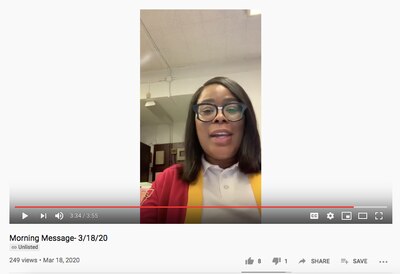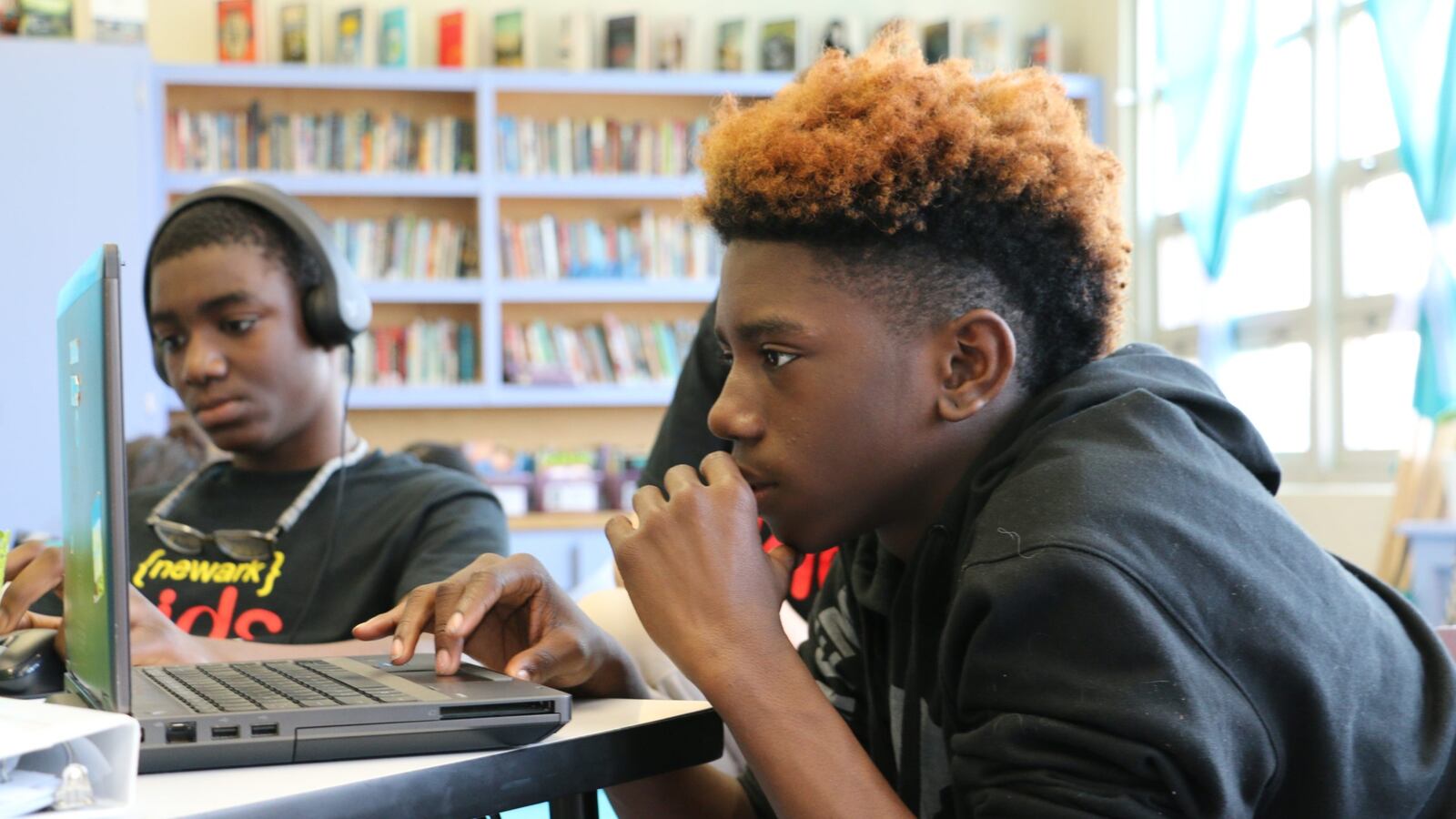As New Jersey enters its fourth week of indefinite school closures, the state’s largest school district says it is ready to go fully online — though what exactly that means remains unclear.
“On Monday, we go virtual all the way until we return back to school,” Newark Superintendent Roger León said during an online event last week.
In some ways, Newark is well-positioned to move its more than 40,000 students to online learning. After schools nationwide began shuttering last month because of the coronavirus, the district loaned out more than 8,000 laptops to families with limited technology at home. Some teachers also began experimenting with online meeting platforms such as Zoom to give virtual lessons. Newark’s swift transition to remote learning put it ahead of other districts that were slower to shift.
But despite those preparations, challenges remain. Some 2,100 students still need laptops, León said last week, and the district-issued Chromebooks have some major limitations. Most notably, they restrict access to Zoom, which has forced students to rely on their personal devices or cellphones in order to join virtual classes.
It is also not clear what virtual learning will entail. Will all teachers begin recording or giving live lessons online? And will the district replace the assignment packets it distributed to students last month with online activities?
León suggested a move away from work packets: “On April 6, Monday morning, we begin all of our virtual classes solely online. Those packets that everyone kind of was looking for, we really need everyone to be online,” he said during a parent conversation hosted by the Abbott Leadership Institute on Friday.
Yet the district has posted new work packets on its website that will last through April, and a spokeswoman said paper packets will still be available. The spokeswoman added that whether teachers will give virtual lessons “depends on the teacher.”
The lack of clear expectations has resulted in a patchwork of practices that vary by school and even classroom, according to interviews with parents and teachers. While some students are getting online lessons that approximate the classroom experience, others are working alone or with their parents and communicating with their teachers mainly by phone or email. To make home learning effective and equitable for all students, some parents want more consistency and clarity from the district.
“We just need everybody to be on the same page,” said Ravyn Thomas, whose daughter is in the third grade at George Washington Carver Elementary School. “It just can’t be chaos and miscommunication.”
🔗The challenges of virtual learning
Unlike wealthier districts where most families are equipped with the latest technology, Newark had to launch a massive effort to help its students learn remotely.
Last month, teachers and administrators showed up on weekends to hand out Chromebooks to families, with some staffers even delivering them to students’ doorsteps. The district also partnered with the cable provider Altice USA to provide temporary free internet to families who need it.
At the same time, teachers scrambled to establish new routines for taking attendance, grading assignments, and checking in with students remotely. Amid such a drastic shift, technical glitches inevitably arose.
“I was up from 6 a.m. until midnight Monday and Tuesday trying to manage the implementation of my classes and making sure that everyone was learning and able to make the technology work for them,” said East Side High School teacher Lilia Arfinengo about the first days of home learning.
In the lower grades, parents and guardians were suddenly responsible for managing their children’s daily studies. Teachers have spent hours answering questions by phone and text, but it has fallen on parents to master unfamiliar online tools.
“I’d never even heard of Google Classroom,” said Thomas, adding that her daughter’s teachers have started using the platform to post some assignments and take daily attendance.
Thomas was grateful that the school lent her daughter a Chromebook, but she soon found that the free Wi-Fi service it relies on was spotty — a complaint echoed by other parents and teachers. Now, just as Thomas was getting into a routine of using the paper work packets in conjunction with Google Classroom, the district says it is shifting to all online work.
“I don’t care if it’s online or paper,” she said. “The controversy comes from changing in the middle.”
The shift to online learning could prove especially daunting for families with multiple children, who will each need separate devices and parent support.
Shamonique Jones has three children in different grades at Louise A. Spencer School. The school loaned Chromebooks to her fourth- and fifth-grade sons, but not her daughter in second grade, Jones said. As a workaround, Jones has been texting photos of her daughter’s written work to her teachers.
Because her children’s teachers have not been giving virtual lessons, Jones has been guiding her children through their separate assignments while also making meals and easing their concerns about the coronavirus.
“Now I have to play teacher, cafeteria lady, social worker,” she said. “I’m doing all the work.”
The district has not made clear whether the shift to virtual learning will require all teachers to give online lessons to help students learn new material. When Chalkbeat asked what guidance the district has provided schools and teachers about virtual learning, a spokeswoman declined to share details.
Those questions “require a more detailed explanation than the time we’ve allotted in this correspondence,” spokeswoman Nancy Deering said in an email last month. “In short, the same responsibilities that existed during school are exactly the same today with the main difference being now they all occur remotely or by phone.”
When asked again on Friday whether all teachers will be expected to give live lessons and, if so, what online platforms they should use, Deering responded: “The answer to both of these questions depends on the teacher.”
🔗A model of what’s possible
With or without guidance from the district, Newark schools are charging forward into the virtual world.
This shift has been most evident among high schools, including some that have created virtual learning schedules specifying the subjects students should focus on each day. Some teachers have also been using Zoom, Google Hangouts, and other platforms to teach new material and check in with students.
University High School, a magnet school that includes grades seven to 12, has modeled this approach.

In order to keep the school community connected, Principal Genique Flournoy-Hamilton records daily video messages, and this Monday hosted online meetings with students in each grade level. The school also plans to offer virtual versions of its clubs, including taekwondo and dance.
Flournoy-Hamilton made the decision early on to ask teachers to record or livestream lessons, not just post assignments. The school hosted virtual training for families and staffers to learn the new online tools.
“They’ve done an amazing job adjusting to our new normal,” she said. Now, “teachers are going on every day and actually instructing in ways that are very similar to the classroom.”
LaToya Waddell is one of the teachers leading the way. At first, few of her seventh- and eighth-graders tuned in for her daily math classes on Zoom, but now she gets nearly perfect attendance. She said the virtual classes force students to keep up with the work while also providing some much-needed social interaction. After a recent session, several eighth-graders said “I love you” to one another before logging off.
Waddell has occasionally had to defend the new approach. When a parent recently said it was difficult getting her daughter to attend the online classes during the quarantine, Waddell said she responded: “I understand that, but I’m trying to provide your child some normalcy here; a place to check in every day.”
She has also held workshops for her colleagues on how to use Zoom and other online tools. Some teachers were hesitant at first, but Waddell encouraged them to give virtual teaching a try.
“Don’t focus on what’s going wrong,” she told them. “Focus on what can go right.”

